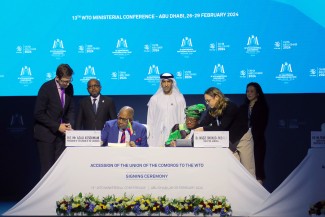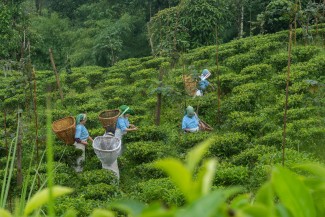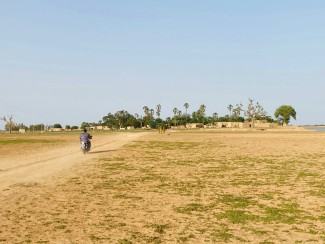Targeting soy and groundnuts for export, the country and its farmers are seeing rewards
The mountains that mark the border with Zambia sit in the distance, framing an expanse of crunchy, golden soy exactly on the brink of harvest.
Bester Glandson stands amid this crop, speaking of her switch to soy farming and what that has meant for her and her family's life.
"I used to not have a house. I was unable to look after my children. My children were poor," she said.
But following her participation in a training program aligned to a refreshed Malawi trade strategy and its pivot to the cultivation of new crops targeted for export, Glandson has seen her income increase.
Through the program managed by the National Smallholder Farmers' Association of Malawi (NASFAM), she was loaned one hectare of land to practice with, and taught how to plant soya and groundnuts.
"In our village, we didn't know much about the proper way to farm," she said, adding that she was taught how to make ridges to plant on and better irrigation techniques.
These skills have translated into good quality yields, and NASFAM assists to connect them to buyers so farmers can be assured of a market for their soya and groundnuts.
And the government and NASFAM are searching out even more markets for the country's agricultural production, looking to trade with neighboring countries and to Europe with processed items.
NASFAM manages both farmland and agricultural processing. At their plant at the Kanengo Industrial Site in Lilongwe, women and men sort peanuts by hand, manage the machines that mill rice and blanche nuts, and bag items for transport.
For Christina Chatima, who is Director of Trade at the Malawi Ministry of Industry, Trade and Tourism, this processing is the key to the country's development.
"Agriculture has been very important to Malawi because traditionally most of the products that we have relied on have come from this particular sector... And the concentration has mostly been on raw products and now we are saying, no we need to add value," she said.
She added, "If you look at raw products they don’t provide the necessary value that you’d want to get... We are trying to industrialize, we are adding value to get more foreign exchange from what we product for export.
"And that is exactly what is happening."
These changes means jobs for people in processing, and, for farmers, more opportunities to sell their crops at a good price.
Chatima said, "The farmers that were involved in the project itself, they have benefited a lot in the sense that they have done this kind of diversification in terms of the income which they are getting the poverty levels they have really gone down they are able to support even children going to school and that is the national agenda to deal with the poverty levels.. We are very happy that we are in a partnership with NASFAM to achieve the implementation of the National Export Strategy as well as the government agenda in terms of poverty reduction."
For Bester, standing behind her house along a dusty road ringed by fields, and other farmers trying out new crops, there have been major benefits.
She said, "My life has improved a great deal. We are making a good profit. I'm now able to buy clothes for my children. I'm able to feed them. But the main benefit is the house. I made bricks for the house, built it and put corrugated iron sheets up for the roof. It's a work in progress."
But, she added, "My future looks bright."
If you would like to reuse any material published here, please let us know by sending an email to EIF Communications: eifcommunications@wto.org.



